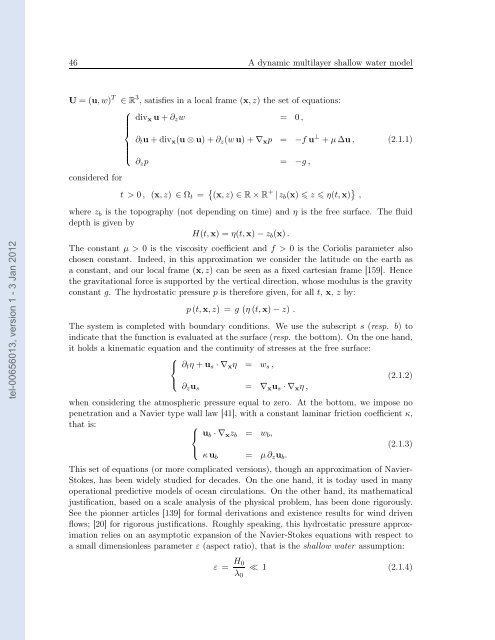Modélisation, analyse mathématique et simulations numériques de ...
Modélisation, analyse mathématique et simulations numériques de ...
Modélisation, analyse mathématique et simulations numériques de ...
Create successful ePaper yourself
Turn your PDF publications into a flip-book with our unique Google optimized e-Paper software.
tel-00656013, version 1 - 3 Jan 2012<br />
46 A dynamic multilayer shallow water mo<strong>de</strong>l<br />
U = (u,w) T ∈ R 3 , satisfies in a local frame (x,z) the s<strong>et</strong> of equations:<br />
⎧<br />
divxu+∂zw = 0,<br />
⎪⎨<br />
∂tu+divx(u⊗u)+∂z(wu)+∇xp = −f u ⊥ +µ∆u,<br />
consi<strong>de</strong>red for<br />
⎪⎩<br />
∂zp = −g,<br />
t > 0, (x,z) ∈ Ωt = (x,z) ∈ R×R + |zb(x) z η(t,x) ,<br />
(2.1.1)<br />
where zb is the topography (not <strong>de</strong>pending on time) and η is the free surface. The fluid<br />
<strong>de</strong>pth is given by<br />
H(t,x) = η(t,x)−zb(x).<br />
The constant µ > 0 is the viscosity coefficient and f > 0 is the Coriolis param<strong>et</strong>er also<br />
chosen constant. In<strong>de</strong>ed, in this approximation we consi<strong>de</strong>r the latitu<strong>de</strong> on the earth as<br />
a constant, and our local frame (x,z) can be seen as a fixed cartesian frame [159]. Hence<br />
the gravitational force is supported by the vertical direction, whose modulus is the gravity<br />
constant g. The hydrostatic pressure p is therefore given, for all t, x, z by:<br />
p(t,x,z) = g (η(t,x)−z) .<br />
The system is compl<strong>et</strong>ed with boundary conditions. We use the subscript s (resp. b) to<br />
indicate that the function is evaluated at the surface (resp. the bottom). On the one hand,<br />
it holds a kinematic equation and the continuity of stresses at the free surface:<br />
⎧<br />
⎨ ∂tη +us ·∇xη = ws,<br />
(2.1.2)<br />
⎩<br />
= ∇xus ·∇xη,<br />
∂zus<br />
when consi<strong>de</strong>ring the atmospheric pressure equal to zero. At the bottom, we impose no<br />
pen<strong>et</strong>ration and a Navier type wall law [41], with a constant laminar friction coefficient κ,<br />
that is: ⎧<br />
⎨ ub ·∇xzb = wb,<br />
⎩<br />
κub = µ∂zub.<br />
(2.1.3)<br />
This s<strong>et</strong> of equations (or more complicated versions), though an approximation of Navier-<br />
Stokes, has been wi<strong>de</strong>ly studied for <strong>de</strong>ca<strong>de</strong>s. On the one hand, it is today used in many<br />
operational predictive mo<strong>de</strong>ls of ocean circulations. On the other hand, its mathematical<br />
justification, based on a scale analysis of the physical problem, has been done rigorously.<br />
See the pionner articles [139] for formal <strong>de</strong>rivations and existence results for wind driven<br />
flows; [20] for rigorous justifications. Roughly speaking, this hydrostatic pressure approximation<br />
relies on an asymptotic expansion of the Navier-Stokes equations with respect to<br />
a small dimensionless param<strong>et</strong>er ε (aspect ratio), that is the shallow water assumption:<br />
ε = H0<br />
λ0<br />
≪ 1 (2.1.4)

















